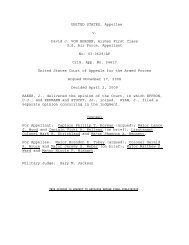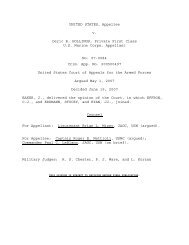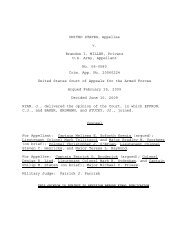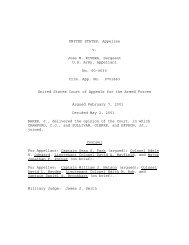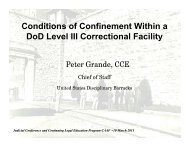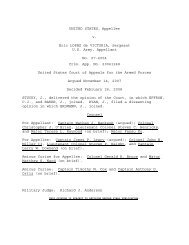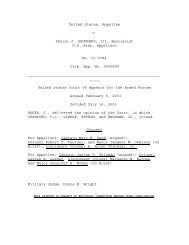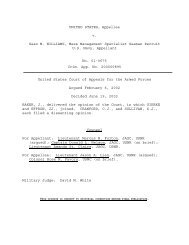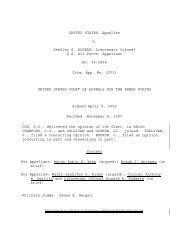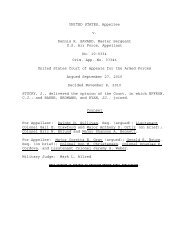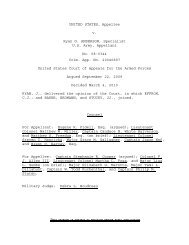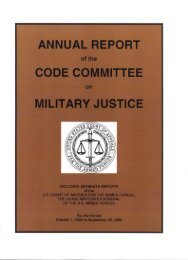U.S. v. Othuru - U.S. Court of Appeals for the Armed Forces
U.S. v. Othuru - U.S. Court of Appeals for the Armed Forces
U.S. v. Othuru - U.S. Court of Appeals for the Armed Forces
Create successful ePaper yourself
Turn your PDF publications into a flip-book with our unique Google optimized e-Paper software.
United States v. <strong>Othuru</strong>, No. 06-0768/NA<strong>the</strong> heart <strong>of</strong> <strong>the</strong> Government’s case. He notes that <strong>the</strong> trialcounsel highlighted <strong>the</strong> statements referring to <strong>the</strong>m “[f]irstand <strong>for</strong>emost” during closing arguments. <strong>Othuru</strong> also notes that<strong>the</strong> only persons who could rebut <strong>the</strong> statements were unavailableto testify.The Government disputes that <strong>the</strong> statements were <strong>the</strong> focalpoint <strong>of</strong> <strong>the</strong> prosecution’s case and points out that <strong>Othuru</strong>presented a stipulation <strong>of</strong> Michelle’s expected testimony thatdirectly contradicted her testimonial statement. The Governmentalso argues that <strong>the</strong> statements were cumulative <strong>of</strong> o<strong>the</strong>rtestimony and evidence which established <strong>the</strong> fraudulent andinvalid nature <strong>of</strong> <strong>Othuru</strong>’s alleged marriage to Michelle.Finally, <strong>the</strong> Government argues that <strong>the</strong> evidence <strong>of</strong> guilt wasoverwhelming even in <strong>the</strong> absence <strong>of</strong> <strong>the</strong> contested statements.To determine whe<strong>the</strong>r <strong>the</strong> constitutional error was harmlessbeyond a reasonable doubt we consider <strong>the</strong> whole record. VanArsdall, 475 U.S. at 681. Reviewing this record we apply <strong>the</strong>balancing test established by <strong>the</strong> Supreme <strong>Court</strong>:The correct inquiry is whe<strong>the</strong>r, assuming that <strong>the</strong>damaging potential <strong>of</strong> <strong>the</strong> cross-examination were fullyrealized, a reviewing court might none<strong>the</strong>less say that<strong>the</strong> error was harmless beyond a reasonable doubt.Whe<strong>the</strong>r such an error is harmless in a particular casedepends upon a host <strong>of</strong> factors, all readily accessibleto reviewing courts. These factors include <strong>the</strong>importance <strong>of</strong> <strong>the</strong> witness’ testimony in <strong>the</strong>prosecution’s case, whe<strong>the</strong>r <strong>the</strong> testimony wascumulative, <strong>the</strong> presence or absence <strong>of</strong> evidencecorroborating or contradicting <strong>the</strong> testimony <strong>of</strong> <strong>the</strong>witness on material points, <strong>the</strong> extent <strong>of</strong> cross-8



